I was talking to a chef friend of mine who also uses a few ceramic kitchen knives. I asked him what he really likes about it. Aside from its sharpness, he also mentioned that his fruits don’t oxidize and turn brown as fast when he uses his ceramic knife to cut it, particularly apples. I knew ceramic knives are chemically inert, and that they’re not supposed to react with your food, but I thought it was in regards to taste, not color!
You probably guessed what I did next. I headed straight to the supermarket and picked up some apples to test this theory. I was really skeptical about the whole thing. But then again, the advice was from a professional chef who uses ceramic knives daily. He wasn’t trying to sell me any knives, he was just being a pal and sharing his knowledge.
I started by cutting one with a $150, newly sharpened Henkels knife and the other with my ceramic knife. I let them sit, taking pictures in random intervals. The results made me say “Oh my gosh!” The apple cut with the regular kitchen knife did indeed turn brown a lot faster than the one I cut with the ceramic knife! See the images below and click on them to enlarge.
After about 15 minutes, the apple wedge cut with the ceramic knife hardly oxidized at all, while the slice cut with the kitchen knife already showed some signs of discoloration. After about an hour and 10 minutes into the test, the differences became very apparent as you can see from the pictures.
I left the apple wedges out even after I was done with the test. The next morning, I was even more surprised at what I saw. The slice cut with the ceramic knife remained in the same condition it was the night before! There was no further discoloration or oxidation. I was amazed!
To be honest, I didn’t think this would really work, but as you can see from the images, it truly does! Now I can feel confident about cutting fruits ahead of time without having to worry about oxidation. Through the couple of weeks I’ve used a ceramic knife, this test really amazed me more than any others. Moving forward with my test, I don’t think anything will amaze me more than this.
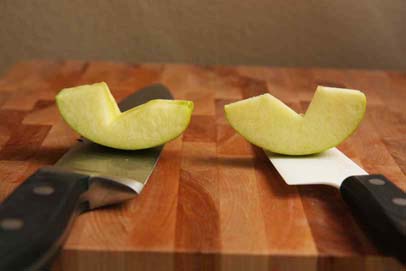
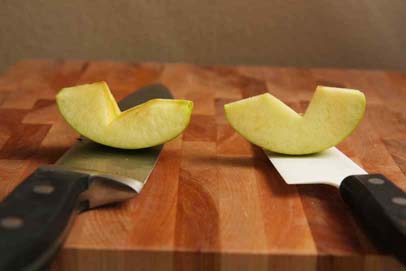
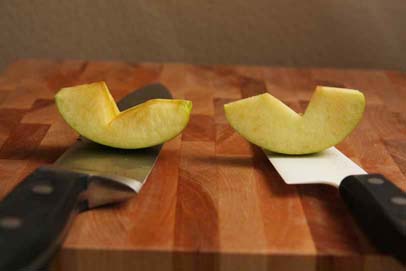
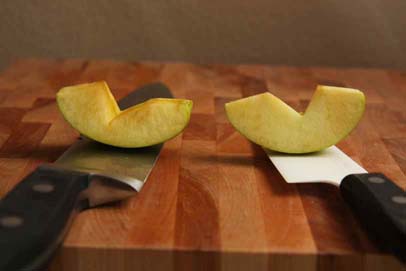
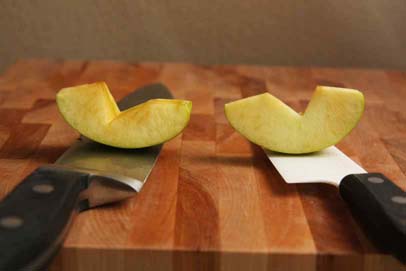
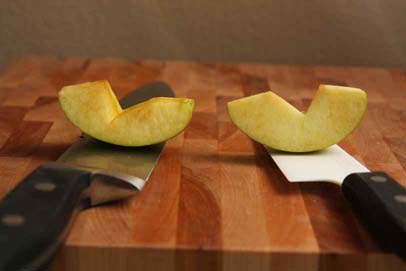
I like seeing independent tests also. I wish some people who are skeptical of various claims would try them. I would like to see the look on their faces. I am talking about the kind of people who don’t believe in synthetic things and such. I know people who don’t think they make a difference. I just ignore that cynicism and make them eat my dust on the road.
I heard about this on TV but it’s nice to see an actual test about it
thank you for the information. I didn’t know this. I wonder if it does the same with avocados
O.o very cool. I’d be interested to see it with other things too, do the avocado test~
Proper knife skills enhance presentation.
very key in successful execution in plate design
Thank you for the feedback everyone. I’ll do the avocado test and post the same side by side images. Come back soon for the results 🙂
Acidic fruits and vegetables react to the metal ions in steel blades. If you slice a tomato with a ceramic knife and follow with a steel blade, you can taste the difference between two slices of the same tomato. I have been to the Kyocera world headquarters in Kyoto, japan and have seen firsthand the marvelous advances in knives there. Hope you publish a comparison between the standard white blade units and the black carbide zirconia? varieties someday. Also, do you know anything about the German Bokar units using Kyocera technology? Kyocera makes world-class printers with their Mita brand units, which cost far less to operate than the other types
we will be using , from now on this knifes at our cooking school thank you
…
I’ve done this test myself and it really works. I used my Diamant Sabatier Delice santoku and my 14cm white Kyocera santoku. The Sabatier had been freshly sharpen and stropped and was like a light sabre. The Kyocera was just taken out of its blade guard. It has a few minor nicks but is still very serviceable. Low and behold, the apple cut with the freshly serviced Sabatier very quickly started to oxidise. The apple cut with the Kyocera started to show slight oxidisation after sitting on the counter over night. It is the same with salad stuff too. I hasted to add, that to get the full benefits of a ceramic knife, you should really be using a ceramic veg peeler too. Kyocera offer a range of these too and they are worth every penny.
Kyocera make fantastic precision knives that will compliment anyone’s steel knives perfectly.
I think even a better and more obvious difference can be seen when peeling and cutting artichokes, like for a fresh artichoke salad, since they oxidize so quickly. The ceramic knives are very helpful there.
Fascinating stuff. Thanks to all for the info. I know that oxidation affects the appearance. And some have said that it affects the taste. Does anyone know if it also affects nutritional value. Yes, I realize that ant effect would be small, but even so, I’m curious if there is an effect. I don’t yet have ceramic knives but I do have a very sharp plastic knife I use for slicing produce like lettuce.
I love my ceramic knives for chopping onions. No burning eyes, no tears!
Recently purchased an inexpensive set, first I noticed the sharpness (shaved with the paring knife!). Noticed the effortless slicing, especially large onions (no tears!) and cheddar cheese (no sticking!).
wow this is amazing =)
what would happen if you would use a knife made from 316 surgical steel also known as 18/10 stainless steel? I doubt the result will be the same in compare with the ceramic knife but really curious about the outcome of such test.
Pingback: Ceramic Knives – Are they worth it? » Knife Source
hi that is awesome I’m going to get one
you helped with my science fair i won 1st place thank you so much
Pingback: How to Sharpen a Ceramic Knife - Best Knife Sharpener Online
Pingback: The Ceramic Chef Knives Review
Funny how a ceramic knife website has nothing but amazing things to say about how ceramic knives keep things from turning brown when the real science behind it has absolutely nothing to do with the knife itself. Laboratory test have confirmed this. Potatoes and apples will brown just as quickly cut with a ceramic knife as when cut with stainless steel. As a chef for over 40 years, having also worked in the cutlery and food science laboratory field, I can attest to this. I have owned both ceramic knives and traditional steel knives and they all are fine and have their place, but these anti-browning claims are inherently false. Sorry to burst your ceramic bubble.
But why do ceramics knives do that?
Hi blogger, i must say you have very interesting content here.
Your website can go viral. You need initial traffic boost only.
How to get it? Search for; Mertiso’s tips go viral
I have noticed you don’t monetize your website, don’t waste
your traffic, you can earn additional bucks every month because
you’ve got hi quality content. If you want to know how to make extra $$$, search for: Boorfe’s tips best adsense
alternative
Pingback: Apples & The Perfect Peanut Butter Honey Dip: A Quick, Healthy Snack - Our Sweetly Spiced Life
Pingback: Reduzca el dorado de los aguacates y otras frutas cambiando sus cuchillos